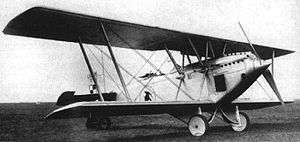Lublin R-VIII
| Lublin R-VIII | |
|---|---|
 | |
| Role | Bomber and reconnaissance aircraft |
| Manufacturer | Plage i Laśkiewicz |
| First flight | March, 1928 |
| Introduction | 1930 |
| Retired | 1939 |
| Primary user | Polish Air Force and Polish Navy |
| Produced | 1928-1930 |
| Number built | 6 |
|
| |
The Lublin R-VIII was a Polish bomber, reconnaissance aircraft and seaplane designed in the late-1920s by the Plage i Laśkiewicz factory in Lublin. It was the first in-house design of Plage i Laśkiewicz, and the first with the name Lublin.
Development
The aircraft was designed in answer to a request of the Polish Air Force for a heavy single-engine reconnaissance and bomber airplane. Work started in 1926. The main designer was Jerzy Rudlicki (the letter "R" in the designation for his name). The prototype R-VIII was flown in March, 1928. It was fitted with a 550 hp (410 kW) Farman 12We W-engine, but in tests proved to be underpowered. In July 1928 the second prototype was completed with a more powerful 740 hp (550 kW) Lorraine-Dietrich 18Kd engine. In August 1928 it flew in the Aviation Contest of the Little Entente and Poland. It achieved the best result in trials of carrying a payload (1024 kg to an altitude of 5000 m).
In 1929, the Polish Aviation Department of War Ministry ordered four aircraft with the designation R-VIIIa. They were built in early 1930. One was fitted with a Lorraine-Dietrich engine, the rest with the 760 hp (570 kW) Hispano-Suiza 12Lb. More were not ordered, as the aircraft had good performance when carrying only a limited payload and fuel reserve (which limited its range), when it carried more bombs, or maximum fuel load, its performance was poor.
The prototypes and serial production aircraft were used by the Polish Air Force only for a short time. In August–September 1930, three R-VIIIa flew in the Aviation Contest of the Little Entente and Poland, taking a mediocre 7th and 9th places. In service, both Lorraine-Dietrich-powered aircraft crashed - in 1930 and 1931.
In 1932, the existing R-VIIIs were converted to floatplanes for the Polish Navy. The first prototype was fitted with Lorraine-Dietrich engine and was designated R-VIII bis (Aircraft number 801). Two planes with Hispano-Suiza engines were designated R-VIII ter (numbers 802 and 803). The fourth aircraft was broken into spare parts. The maximum speed of the floatplane variant was lowered to 200 km/h. They were also called R-VIII/hydro.
A six-seat passenger plane, the R-IX, was developed in 1929, based on the R-VIII, but it remained a prototype.
Operational service
The R-VIII floatplanes were used by the Polish Naval Aviation Squadron (MDLot) in Puck from 1933, in a long reconnaissance escadre. From 1938, they were assigned to training, and were scheduled for withdrawal from service. They survived until the Invasion of Poland in 1939, but the R-VIII bis had its engine removed by then. After the first German air raid on naval aviation base in Puck on September 1, all floatplanes were evacuated from Puck to the Hel Peninsula (the bulk were Lublin R-XIIIs). Since R-VIIIs were quite obsolete by then, they were not used in combat. They were anchored on Puck Bay by Chalupy on Hel Peninsula, near the base of the peninsula, where they were bombed by Stukas on September 8.
Description
Wooden construction biplane, conventional in layout. A fuselage was rectangular in cross-section, plywood covered. Wings canvas and plywood covered, upper wing of greater span. Crew of two, sitting in tandem in an open cockpit, with twin controls (three crewmen could be carried as well, with radio operator). Conventional fixed landing gear, with a rear skid, or two Short floats.
The pilot had one fixed 7.7 mm Vickers machine gun with an interrupter gear, the observer had twin 7.7 mm Lewis machine guns on a ring mounting. Bomb load: in bomber variant up to 1000 kg, in seaplane variant - 300 kg. The plane was fitted with a camera.
Engine:
- 18-cylinder inline W engine Lorraine-Dietrich 18Kd 650 hp (480 kW) power, 740 hp (550 kW) take-off power, water-cooled (second prototype, one serial R-VIIIa, R-VIII bis)
- 12-cylinder inline V-12 engine Hispano-Suiza 12Lb 650 hp (480 kW) power, 760 hp (570 kW) take-off power, water-cooled (three serial R-VIIIa, R-VIII ter)
Two-blade propeller, 4.4 m diameter. Fuel tank 1200 l in the fuselage, which could be dumped in case of fire. There could be mounted an additional fuel tank, increasing the range to 1720 km, though this reduced the bomb load.
Operators
Specifications (R-VIIIa, Lorraine-Dietrich)
General characteristics
- Crew: 2, pilot and observer
- Length: 11.12 m (36 ft 6 in)
- Wingspan: 17 m (55 ft 9 in)
- Height: 4.5 m (14 ft 9 in)
- Wing area: 76.4 m² (822 ft²)
- Empty weight: 2457 kg (5,405 lb)
- Useful load: 1043-1843 kg (2,294-4,054 lb)
- Loaded weight: 3500 kg (7,700 lb)
- Max. takeoff weight: 4300 kg (9,460 lb)
- Powerplant: 1 × Lorraine-Dietrich 18Kd water-cooled 18-cylinder inline W engine, 740 hp / 650 hp nominal power (552 / 484 kW)
Performance
- Maximum speed: 225 km/h (138 mph)
- Cruise speed: 200 km/h (123 mph)
- Stall speed: 85 km/h (52 mph)
- Range: 600-1720 km (370-1061 mi)
- Service ceiling: 5770 m (18,925 ft)
- Rate of climb: 5.25 m/s (1,033 ft/min)
- Wing loading: 45.8 kg/m² (9.36 lb/ft²)
Armament
- 1 × fixed front-firing 7.7 mm Vickers E machine gun
- 2 × movable 7.7 mm Lewis machine guns
- 1,000 kg (2,200 lb) bombs (300 kg (660 lb) in floatplane variant)
See also
- Aircraft of comparable role, configuration and era
References
- Andrzej Glass: "Polskie konstrukcje lotnicze 1893-1939" (Polish aviation constructions 1893-1939), WKiŁ, Warsaw 1977 ((Polish), no ISBN)
External links
| Wikimedia Commons has media related to Lublin R-VIII. |